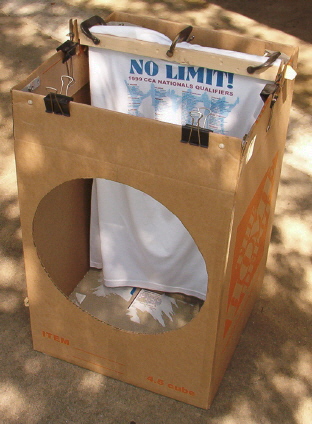
What is a backstop?
A backstop is a device that safely catches your projectiles. It serves
three purposes. First, it prevents ricochets that can pose a danger to the shooter and bystanders.
Second, it allows you to re-collect and re-use your ammunition. This is good for the environment and
keeps shooting costs low. Third, a sufficiently large backstop allows you to practice indoors without
damaging walls and furniture.
Most backstops are, essentially, a suspended piece of fabric that has some
space behind it. The projectile connects with the fabric, continues in its path
and rapidly loses energy due to the fabric pulling it back. This puts a lot of
stress on the backstop. Tightly knit fabrics (such as Jersey = old t-shirts) typically
have a longer lifespan than stiff, coarsely woven fabrics like towels or woven sheets.
Simple Catchbox

A simple Backstop can be made from a cardboard box and old t-shirts. Clamp 2-3 old
shirts between two lengths of lumber, using three C-clamps. Leave about 20cm free
space between the shirts and the rear of the Box. Add Office paper clips or pieces of wire
to hang a target into the front opening.
Open backstops

An open backstop is typically a blanket that hangs from a line, and a second blanket or plastic sheeting that lies on the
ground to collect the ammunition. This type of backstop is preferred for tournaments and gatherings. Its large size makes it
more reliable than a small catchbox.
What makes a good backstop?
The seemingly simple desing of a backstop is deceptive. It is not that easy to make a good one
that reliably catches all projectiles from different slingshots and has a long lifespan.
Choose the right material. Finely knit fabric, such as old t-shirts, jeans, bedsheets etc. work best.
Archery protection nets are expensive, but work great if you need to cover a large wall.
Bigger is better. A large backstop is better in recollecting ammo, covers a larger area for saftey and typically responds better
to projectiles of different weight and speed.
Don't attach your suspension line to your backstop by threading it through holes. The force from
the impacting shots will quickly tear these weak spots apart. Instead, connect them by making big knots
into the rug and tying the suspension line to them.
Metal cans are fun targets, but they develop sharp edges after some shots, and often do damage to the backstop.
You can either hang them far enough away from the rug, or use paper or leather targets instead.
Large backstops can be expensive. It makes sense to protect them with small sacrificial rugs that hang right behind
the targets and can be exchanged. Keep a bit of space between the small rug and the large backstop.
A lightweight rug that moves freely last a lot longer, as it can travel along with the projectile. Again, it makes sense to
have a small backstop to catch most shots, and a larger one behind to prevent damage from stray shots.
Always keep space between your rug's suspension and the intended impact area of the projectiles. The more space you have, the
better will your backstop work.
Wind may force you to tie the rug to the ground.This is best done with rubber bands that still allow the rug to move backwards.
















